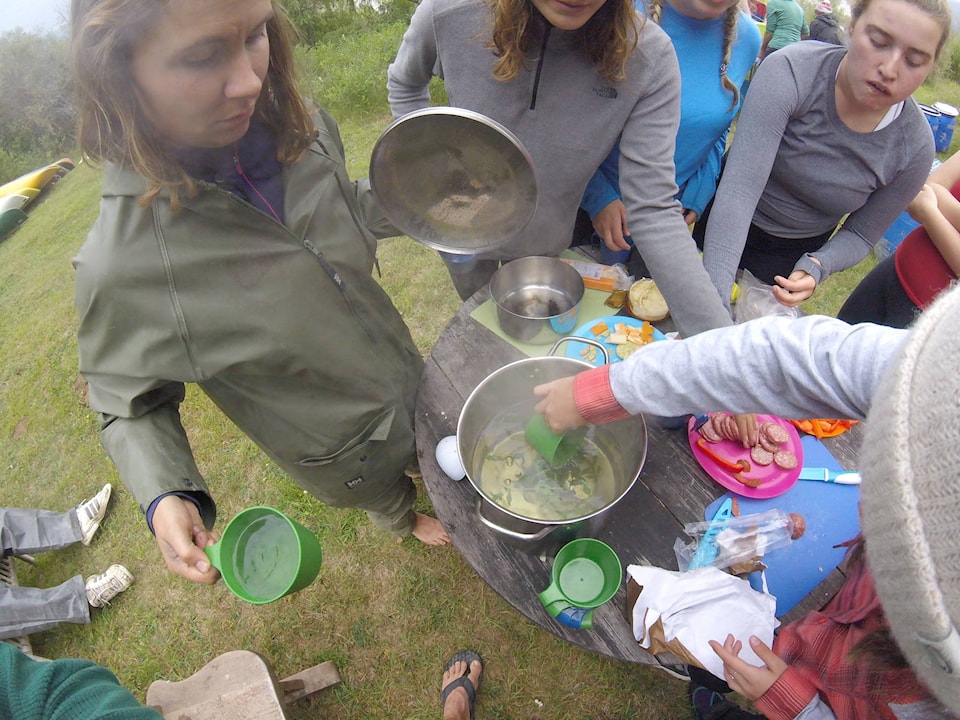By Eileen Delehanty Pearkes
Observant shoppers in local grocery stores may have recently noticed a few energetic young people shopping for the two-week-long Columbia River Field School. There would have been at least two buggies, maybe a third, filled to the brim. Before the school is over, organizers will have served nearly 1,000 meals, including 233 servings of chocolate, 160 eggs, 142 servings of cucumber and 335 granola bars.
In some ways, it’s a typical school, filled with hungry, enthusiastic teenagers. In other ways, it is unique. CRFS focuses on what can be learned outdoors rather than in, by offering a for-credit high school course to 16 youth from the East and West Kootenay. Students have a chance to explore the vast, complex and beautiful upper Columbia River watershed firsthand. In canoes. Hiking. Observing and learning about the beginnings of the fourth-largest river by volume in North America.
The course starts at Premier Lake in the East Kootenay, where many of the students step into a canoe for the first time. After a few days of instruction in how to stay balanced and paddle the water, they journey to Canal Flats, where they learn about the shape and water dynamics of the Columbia’s headwaters. For the next 10 days, they travel in a mix of canoe and van, by river and road, visiting Revelstoke Dam, the Spicer Farm in Nakusp and paddling their way toward the completion of the course at Robson.
The logistical challenges of navigating the region are well known to anyone who tries to see Mica Dam (135 km north of Revelstoke), or make a quick trip from Castlegar to Trout Lake, or Radium Hot Springs to Fruitvale. The high mountains whose snow feeds the Columbia are regular impositions for those of us in cars. Those who stick to the water find it even more challenging, especially with dams in place.
As a student myself of the Columbia River region’s natural and human history for nearly two decades, I am watching with great admiration the efforts being made by the nascent CRFS. In its second year of operation, it helps regional youth come in close contact with the river system. In today’s world, that’s a gutsy idea, involving a trailer that carries eight canoes, plus volunteer drives to shuttle vans and cars from one location to another, piles of life-vests and all the expected tents, camp stoves and sleeping bags. And the food, of course.
Key players are Monica Nissen from Wildsight, an East Kootenay-based advocacy group that receives funding from the Columbia Basin Trust; School District 8; the Real Estate Foundation of B.C.; and the Royal Bank of Canada. Graeme Lee Rowlands, an American educated at Quest University in Squamish, Grace Broadfoot, a local teacher and canoe instructor, and Roger Warnatsch round out the team. For more information about the CRFS, go to wildsight.ca/fieldschool.
The group will land their canoes just a few weeks before the sixth International Columbia Basin Transboundary Conference taking place in Kimberley, Sept. 12 to 14. Key Canadian members of the Columbia River Treaty negotiating team will be present at the conference, following the eighth round of international negotiations in Cranbrook on Sept. 10-11.
Many river stakeholders from both sides of the international boundary will also attend the conference, including Indigenous/tribal leaders. There will be an art exhibit, performances, a local foods banquet and many interesting sessions about the future of the Columbia River basin. For more information or to register, see: transboundaryriverconference.org.
Local author Eileen Delehanty Pearkes writes here once a month.
